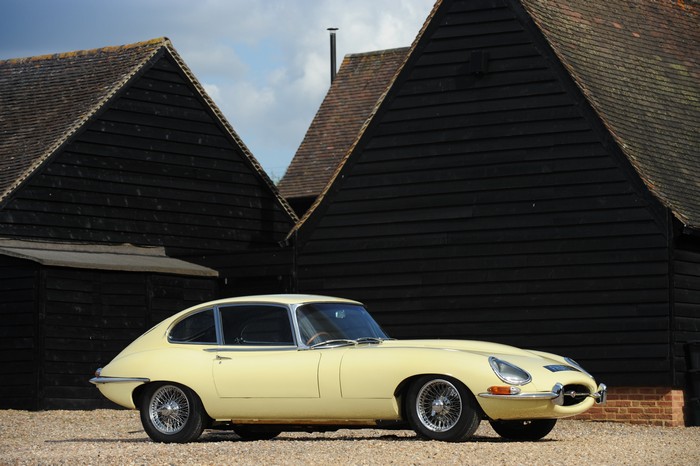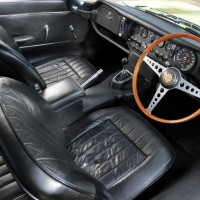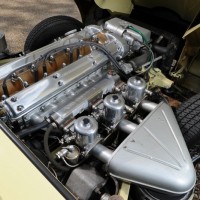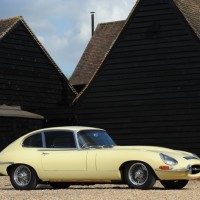SCM Analysis
Detailing
| Vehicle: | 1966 Jaguar E-type Series I 2+2 coupe |
| Number Produced: | 3,618 |
| Original List Price: | $6,070 |
| Tune Up Cost: | $200 (more if valve clearances need reshimming) |
| Chassis Number Location: | Horizontal plate at base of scuttle on right side |
| Engine Number Location: | Stamped on horizontal shelf above oil filter, on right of block |
| Club Info: | Jaguar E-type Club |
| Website: | http://www.e-typeclub.com |
This car, Lot 131, sold for $57,929, including buyer’s premium, at Bonhams’ Goodwood Revival sale on September 15, 2012.
Swan or ugly duckling? Coupe or hearse? Bolster, of course, was referring to the two-seater coupe — and there is a difference between the coupe and the 2+2.
The 2+2 is traditionally the unloved E-type because of its — from some angles — gawky looks, brought upon by a nine-inch stretch in the wheelbase and a higher roofline, both in the name of providing occasional rear-seat availability, although only for children or double amputees.
The most noticeable first-glance difference isn’t the stretch or the roof height so much as the larger windshield, which looks more steeply raked than the roadster’s — but isn’t. Once you’ve clocked that, then the square-rigged frontal profile juxtaposed with the faintly pregnant-looking midriff become the elephant in the room — and impossible to ignore.
Since the Series 1 E-type, as it left Coventry, has fairly rubbish brakes, poor lighting and is a pain to get in and out of, you buy it for its looks. As The Toecutter said in the original “Mad Max”: “Pretty face… but what if you lose the face..?”
It wasn’t all bad in this case, for the 2+2 addresses some of its more-elegant older sister’s shortcomings. As a 4.2 (there were no 3.8 2+2s), it enjoys Jaguar’s four-speed synchro gearbox rather than the slow Moss box carried over from the XK 150 — although many have now been replaced by five-speeders in any case. 4.2s also featured a host of improvements, such as a better Lockheed brake servo replacing the old Kelsey-Hayes bellows type and better ventilation.
This car was pre-Series 1½ facelift (which, of course, we Brits blame on the Americans), so it still had the covered headlights. The car was presented in one of the most sympathetic colors for the coupe, unsullied by a sliding sunroof which only draws attention to the high roofline, and it wasn’t an auto, with which so many 2+2s are afflicted.
Our subject car had been gone though — and generated some big bills at — various top-line Jaguar specialists. These shops are all known for their immaculate output — resulting in a very straight and proper automobile, with a decent interior. Furthermore, its chassis number, 50112, makes it a very early example of its type, which started at 50001, and shows it to be an original right-hand driver and not a converted export car.
Are 2+2s on the rise?
As an early E, this car ticked all the right boxes — except the most glaring one. And so we’re down to a question of vanity. Can you live with the poor cousin, or should you not bother at all? On the basis that all Series 3 coupes are 2+2s and all V12s are on the long wheelbase, does it matter?
For some folks, it will. Having now whittled the market down to the sector for which the looks aren’t an issue, then the next question is: Have the high prices achieved recently by the most desirable E-types, the Series 1 roadsters (Open Two-Seaters in Jaguar-speak), inflated the second-string cars?
That’s what’s been happening in the Aston Martin World, as the rise of the DB5 has recently pulled up the DB6, encouraging buyers to look down the chain and conferring extra — or maybe the correct — value on the DBS. Not so long ago available for $25k, top DBSs now sell for more than $100k, although they still cost more than that to restore properly, so call it the long view.
I suspect that’s what’s happened in this 2+2 transaction, even though E-type prices have settled back slightly since the fanfare of the model’s 50th birthday last year.
This price isn’t a one-off — an expensively restored black S2 2+2 was bid to $69,288 but did not sell at Silverstone Auctions earlier this year (SCM #201966). We’ll try to forget the Bondo-ridden horror that was featured on a British TV restoration show recently — and was ambitiously valued at £30k ($47k) by an industry figure who should have known better.
Perhaps the market has finally woken up to the fact that Jaguar won’t be making any more, and this is a rare model worth preserving. Only 974 right-hand-drive 2+2s were built, and 2,644 left-handers, out of a total production of 31,699 Series 1 cars, both 3.8-liter (15,498) and 4.2-liter (16,201).
If you can live with the looks (and I’m sure 90% of people can’t tell the difference; it’s just SCM types getting precious about purity), this was a very sound car.
Peace of mind over the very thorough restoration work must make it worth the price paid, which is about half the market value of a Series 1 roadster in similar condition. So I’ll stick my neck out here and say that, taking the long view, this was well sold but also correctly bought, with the caveat that the 2+2 market is a small one, and that won’t help at resale time.
(Introductory description courtesy of Bonhams.)




